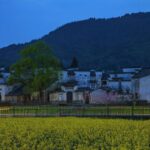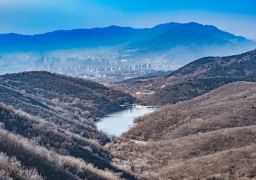The millennium-old temple – Jinxian Temple. It was founded in the Liang Dynasty of the Southern Dynasties and has a history of thousands of years. After several destructions and reconstructions, its style remains unchanged. The mountain gate of the temple is facing Baiyang Lake. A pair of stone lions in front of the gate are gazing longingly at the still clear and blue lake water that has endured for thousands of years. Whenever the setting sun shines from the west and the setting sun is like blood, the surrounding area is in silence. The deep and sonorous bell sound comes slowly, carrying the patina of a thousand years and filling every corner. Tired birds fly across the lake and through the bell sound and return to their nests respectively. According to the Guangxu edition of Cixi County, the temple was built in the Datong period of the Liang Dynasty in the Southern Dynasties and has a history of more than 1,400 years. It was originally named Jingjin Nunnery. During the Qianyuan period of the Tang Dynasty, Zen Master Fulin Duozhi lived here and renamed it Fulin. In the second year of Zhining period of the Song Dynasty, because Baiyang Lake was once named ‘Jinxian Lake’, the imperial court bestowed the name Jinxian Temple and it became a famous temple in eastern Zhejiang at that time. In the 38th and 59th years of the Kangxi period of the Qing Dynasty, it was expanded twice. In the 15th year of the Daoguang period, it was destroyed by fire and soon rebuilt. In the first year of the Tongzhi period, it was destroyed again by war. In the 12th year of the Tongzhi period, it was rebuilt. In the 1980s, Yao Yunlong, a believer from Cixi who was living in Hong Kong, saw that Jinxian Temple is located in the Baiyang Lake scenic area and made a donation to renovate the temple. In the nearly ten years since then, the Buddha hall, Heavenly Kings Hall, Wanghu Tower, Baihu Lecture House and the guest rooms on both sides have been restored. And new buildings such as the Jade Buddha Pavilion and Ten Thousand Buddha Tower have been built. Now there are 172 halls and rooms of various kinds, covering an area of 42 mu. The halls are magnificent and the Buddha statues are solemn, becoming a relatively large-scale Buddhist monastery in eastern Zhejiang. Open all year round and all day.
Jinxian Temple
The millennium-old temple – Jinxian Temple. It was founded in the Liang Dynasty of the Souther[...]









